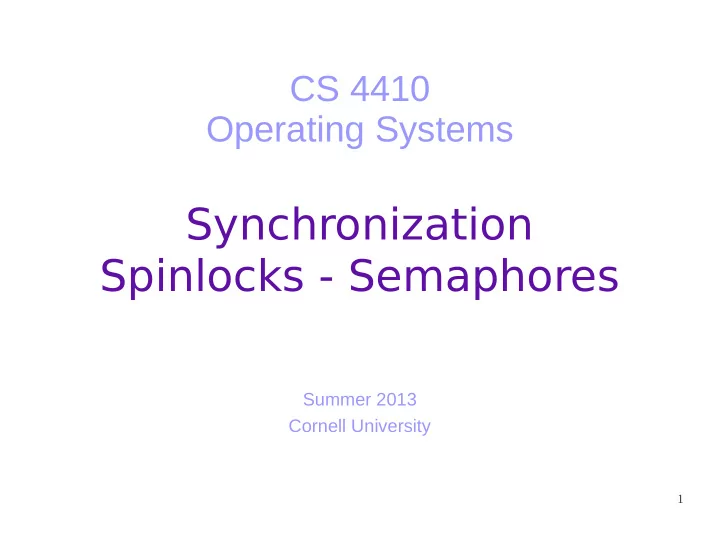

CS 4410 Operating Systems Synchronization Spinlocks - Semaphores Summer 2013 Cornell University 1
Today ● How can I synchronize the execution of multiple threads of the same process? ● Example ● Race condition ● Critical-Section Problem ● Spinlocks ● Semaphors ● Usage 2
Problem Context ● Multiple threads of the same process have: ● Private registers and stack memory ● Shared access to the remainder of the process “state” ● Preemptive CPU Scheduling: ● The execution of a thread is interrupted unexpectedly. ● Multiple cores executing multiple threads of the same process. 3
Share Counting ● Mr Skroutz wants to count his $1-bills. ● Initially, he uses one thread that increases a variable bills_counter for every $1-bill. ● Then he thought to accelerate the counting by using two threads and keeping the variable bills_counter shared. 4
Share Counting bills_counter = 0 ● Thread A ● Thread B while (machine_A_has_bills) while (machine_B_has_bills) bills_counter++ bills_counter++ print bills_counter ● What it might go wrong? 5
Share Counting ● Thread A ● Thread B r1 = bills_counter r2 = bills_counter r1 = r1 +1 r2 = r2 +1 bills_counter = r1 bills_counter = r2 ● If bills_counter = 42, what are its possible values after the execution of one A/B loop ? 6
Shared counters ● One possible result: everything works! ● Another possible result: lost update! ● Called a “ race condition ”. 7
Race conditions ● Def: a timing dependent error involving shared state ● It depends on how threads are scheduled. ● Hard to detect 8
Critical-Section Problem bills_counter = 0 ● Thread A ● Thread B while (my_machine_has_bills) while (my_machine_has_bills) enter critical section enter critical section enter critical section enter critical section – – bills_counter++ bills_counter++ exit critical section exit critical section exit critical section exit critical section – – print bills_counter 9
Critical-Section Problem ● The solution should ● enter section satisfy: ● critical section ● Mutual exclusion ● exit section ● Progress ● remainder section ● Bounded waiting 10
General Solution ● LOCK ● A process must acquire a lock to enter a critical section. ● Hardware or Software-based implementation 11
TestAndSet ● Hardware instruction. ● Test and modify the content of one word atomically . boolean T estAndSet(boolean *target){ boolean rv = *target; *target = TRUE; return rv; } 12
Share Counting bills_counter = 0 lock = FALSE ● Thread A ● Thread B while (machine_A_has_bills){ while (machine_B_has_bills) { while (TestAndSet(&lock)) while (TestAndSet(&lock)) ; ; bills_counter++ bills_counter++ lock = FALSE; lock = FALSE; } } print bills_counter boolean T estAndSet(boolean *target){ boolean rv = *target; *target = TRUE; return rv; 13 }
Swap ● Hardware instruction. ● Swap the contents of two words atomically . void Swap (boolean *a, boolean *b){ boolean temp = *a; *a = *b; *b = temp; } 14
Share Counting bills_counter = 0 lock = FALSE ● Thread A ● Thread B while (machine_A_has_bills){ while (machine_B_has_bills) { keyA = TRUE; keyB = TRUE; while (keyA == TRUE) while (keyB == TRUE) Swap(&lock, &keyA); Swap(&lock, &keyB); bills_counter++ bills_counter++ lock = FALSE; lock = FALSE; } } print bills_counter void Swap (boolean *a, boolean *b){ boolean temp = *a; *a = *b; *b = temp; } 15
But... ● TestAndSet and Swap are complicated for application programmers to use. ● What is the alternative? 16
Semaphores ● Integer value ● Atomic operations ● wait ● signal wait(S) { signal(S) { while S <= 0 S++; ; } S--; } 17
Share Counting bills_counter = 0 S = 1 ● Thread A ● Thread B while (machine_A_has_bills){ while (machine_B_has_bills) { wait(S); wait(S); bills_counter++ bills_counter++ signal(S); signal(S); } } print bills_counter wait(S) { signal(S) { while S <= 0 S++; ; } S--; } 18
Spinlock ● This implementation of Semaphors, TestAndSet and Swap are spinlocks. ● They require busy waiting . ● The waiting processes should loop continuously in the entry code. ● Valuable CPU cycles are wasted . ● Solution: ● Block the waiting process. ● Signal blocked process when the semaphore is “available”. 19
Semaphores typedef struct { int value ; struct process * list ; } semaphore; wait (semaphore *S) { signal (semaphore *S) { S->value--; S->value++; if (S->value <0) { if (S->value <= 0) { add this process to S->list; remove a process P from S->list; block (); wakeup (P); } } } } 20
Usage ● Binary semaphore (mutex) ● Ranges between 0 and 1. ● Ex. Only one process can access a resource. ● Counting semaphore ● Ranges, usually, between 0 and N. ● Ex. N resources and M processes that share the resources. ● Synchronization ● Ranges between 0 and 1. ● Ex. Process A should do task At after process B having done task Bt. 21
Today ● How can I synchronize the execution of multiple threads of the same process? ● Example ● Race condition ● Critical-Section Problem ● Spinlocks ● Semaphors ● Usage 22
Recommend
More recommend